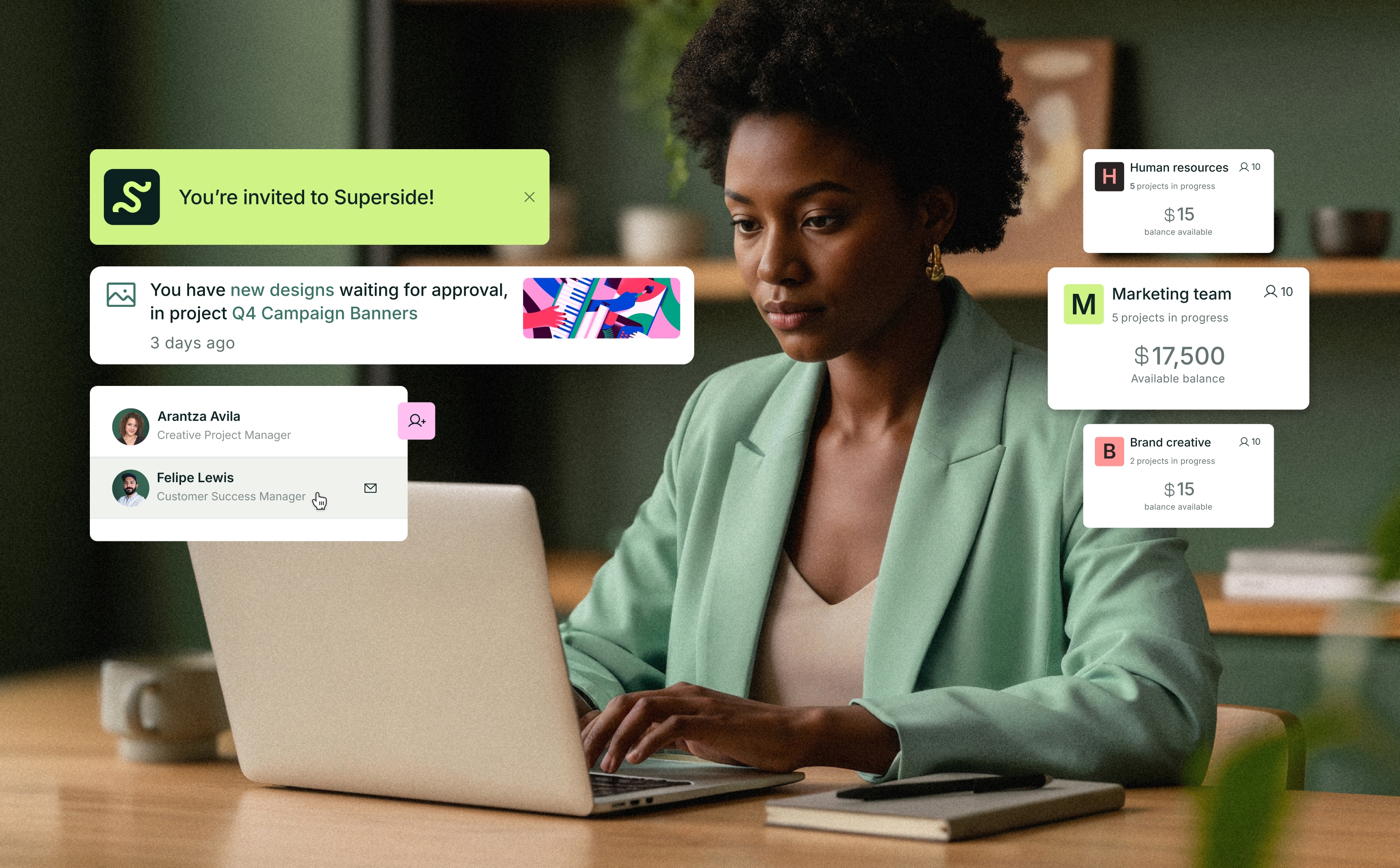
Humanity is having a reality check. We’re learning there’s no corner of our hearts that can’t be replicated by digital learning models, and there’s equal dismay and delight to go around. Tools like Dall-E and ChatGPT have the “A” and “I” keys of every tech writer practically steaming.
But somewhere between the umpteenth self-driving car crash and the twenty-millionth image of an astronaut, it’s become clear that we need to be choosy about what we pass off to the bots. The smartest toothbrushes still need a human hand to guide them, and none are a replacement for a dentist.
Businesses of varying sizes are trying their hand at AI for marketing and creative purposes, and yielding mixed results in the process. We have an understandable hunch that it can make things easier (and let’s be honest, cheaper), but don’t know where the lines are just yet.
AI as Part of Your Marketing Strategy
Marketers and creatives were among the first to start toying with AI, and they’re learning it’s a balancing act. They’re consistently tempering the clear benefits of AI’s speedy turnaround with its frequent need for human intervention. It’s a code to be cracked, and those who’ve slipped the lock say they’ve upped their output across the board.
Sifting through the testimonies of both the doomsayers and evangelists, we’ve compiled a list of what today’s creatives, marketers, and creative-marketers can use AI for in their daily duties.
What You’ll Learn
AI for Copywriting
You can only witness so many AI generated LinkedIn posts touting their origin before concluding that these models may be of some use to marketers. When the ChatGPTs of the world aren’t answering snarky questions about their plan for hostile takeover, the best of the bunch have proven effective at generating marketing copy.
But don’t fire your copywriter just yet. You don’t just want “marketing copy”, you want damn good marketing copy. Pulling copy of this caliber depends on the strength of the prompts given—strength that comes from your brand's communicators (copywriters). Even so, the resulting copy may still need some amount of editing to be brand-aligned, impactful or even factual.
So, how can AI help with copywriting? Well, if you don’t fancy yourself a writer, it allows you to make passable marketing copy with the right inputs. If you’re not at the point of hiring a copywriter, you can use AI to help cover your copywriting gaps in the interim.
For writers, AI’s primary benefit is volume. The requests for brand copy are endless, and copywriting teams are often small. When writers have multiple assignments with competing deadlines, they can use text generators with annotated texts to make copy for lower priority projects. Note that this still demands a deep understanding of the subject matter, and most certainly some amount of editing. It just means less time is spent thinking about what to write. There are many worthy AI content creation and AI Humanizer tools now available in the market and some even have AI Detector tools that help you identify whether the writing piece looks human-like or not and it is a good idea to check whether the content you created passes the text or not.
Ideation is another plus. For some projects, copywriters can use AI to generate quickfire ideas that can grease the gears when they’re sputtering.
AI for SEO
To find the right keyword is to find the right viewer—it can be the difference between 15 and 15,000 readers. While modern SEO tools have alleviated the need for manually compiling keyword lists based on a list of adjacent Google searches, AI is streamlining the streamlined.
Tools like ChatGPT are currently available for public use, and SEO marketers are having a field day testing its powerful engine with prompts like “give me 10 keywords about HR management software”. The potency of these keywords is, like most things ChatGPT, up for debate. But it can be a surprising source of ideas when the marketer’s cylinders aren’t all firing at once.
Beyond keywords, you can also build out SEO-based content with suggestions stemming from your previous prompts. What should your blog about the "Top 5 HR Management Tools" look like? What are its proof points, and how can you work your keywords into the copy? Ask the learning model.
Other paid tools may offer a better track record, with better integration into your marketing tech stack. Such applications can assess the search value of content topics and existing pages, and provide actionable, data-backed keyword recommendations. Additional features can predict the performance of new or re-optimized content.
AI for Content Ideation & Development
There was a time around early mechanization when everyone wielding a hammer did a big, nervous gulp. The writers around them consoled themselves with the knowledge that at least they could never be replaced, and today we pay back our debt with a nervous gulp of our own.
As the dust around language tools clears up, though, we’re finding the name of the game isn’t so much replacement as it is integration. The content team of the future is one who’s made AI part of their strategy: Teams can streamline the content creation process by familiarizing themselves with learning models ASAP.
Why “familiarize” and not “farm out every last character”? We’ll explain a few sections below, but it’s increasingly important that marketers try their hand at upping content volume with language processing tools. The potential routes for someone to come into contact with your content are endless, and as marketing tools become more powerful, we’re watching those avenues multiply. Successful content teams have a story for each of them—a blog, a guide, a webinar, a post, a quiz—and they have limited time and resources to build them.
At least until now, when a content marketer can fast-track an asset’s ideation and creation with AI. As with the copywriter, asking a language processor to give you ideas for an article on subject X, or even write the article will result in content at a moment’s notice. The prospects of that turnaround are unbeatable (though not without fault), and call for deep experimentation on the part of marketers in the coming years.
AI for Creative Ideation & Development
Okay, you knew this one would be here. It was the images of cats in spaceships and Shreks riding Donkeys that kickstarted the renewed cultural interest in AI-generated-anything. AI in design is still a topic of debate, but as with the writers above, they’re finding value in the potential for ideation and streamlining of cumbersome design processes.
Aside from relieving the design equivalent of writer’s block (designer’s block, surely), image generators can also be prompted to produce variations on a design within seconds. The most effective designs to test can be created quickly, and multiple prototype versions can be A/B tested with users.
Only time will tell how AI design projects play with audiences in the long run, but there are promising results thus far in the hands of skilled design teams.
AI for Growth Marketing
Growth marketers lean on the numbers side of your team, so it’s probably less surprising to learn that many have begun using digital learning models to fast-track key processes.
With AI in ecommerce, some growth teams are drilling deeper than ever into their customer profile, expanding their ICP, clean data in their CRMs, score and distribute leads, write and optimize code, automate sentiment analysis through select channels and come up with new ideas.
These capabilities enable other teams as well. AI for growth empowers marketers to collaborate across departments, automating sentiment analysis gives you something to offer your content peers, who may be eager to fill gaps with responsive assets.
Explore how our AI Ad Creative Service can revolutionize your creative process, scale your ad creative and lots more.
AI for Email Marketing
How many emails does the average marketing team send out in one week? The answer is don’t think about it. You don’t need that on your conscience.
You know what else a marketer doesn’t need? To spend countless hours crafting emails every week. Surely there’s room in your email marketing strategy for one more automation: Cutting down the time you spend on email marketing.
"Using the 'Problem-Agitate-Solve' framework, please write an email marketing campaign that identifies the most painful [problem] faced by [ideal customer persona] and agitates the issue to show why it is a bad situation. Then, present our [product/service] as the logical solution to the problem.” That’s an example prompt from top eCommerce email marketer Chase Dimond, and it highlights the depths to which marketers can drill language tools for brand-centric email copy.
By providing AI language tools with a detailed framework for the message, much of the legwork is done for you. Being perhaps the world’s biggest know-it-all, a tool like ChatGPT can make use of your marketing jargon in a way your family and friends probably can’t.
AI for Quick Learning
Marketers are constantly poking around for new ways to connect with their targets. They read a lot, and often wish they had the time/energy/additional eyeballs to read more. They’re limited by their earthly faculties when absorbing content, and not all content is quickly absorbed. The really deep stuff tends to be long, and the marketer’s day all too short.
What a stroke of luck, then, that the marketer can use AI to summarize key points from most written content. Try it yourself: Ask a text-based learning model to give you five takeaways from the latest Harvard Business Review joint, and get your content bite-sized.
It may not be perfect, and it may not be what you would’ve come away with, but hey—you weren’t even going to read it. It’s a small win, but a win nonetheless.
AI for Customer Messaging & Nurturing
Good marketing is meeting the right person with the right message at the right time. There’s a lot of room for variation in that formula, making it laborious to comb through every possibility on your own. With the right predictive tool in your marketing stack, AI can gather data about customer preferences as far as frequency, channels, and timing of sent messages.
There are models that integrate with your analytics tools, and they can take the burden of manual data extraction off your hands. Try the following: By comparing the number of messages sent to clients to the number of active clients, AI can illustrate your targets’ preferences for interaction.
For example, some customer groups just won’t use certain channels. Someone who is unlikely to open an email won’t be persuaded by a notification sent to their phone or social media account. The same applies to optimizing the time of shipment of content, reaching the customer when they’re most likely to pay attention to your message.
What Creative Marketers Can’t Use AI For
Naysayers to AI-generated content report a “blandness” they say prevents deeper engagement. While it’s easy to write this off as placebo—if the naysayer knows content is produced by AI, they’re more likely to find faults—it may serve marketers and creatives to heed the skeptics’ warnings before going all-in.
As these models learn by combing through and aggregating information to find the “answer” to any given prompt, there’s a ceiling on AI’s ability to break new ground. Without detailed instruction/a great deal of editing, it frequently struggles to produce novel ideas. When the source is built on aggregation, the most popular narratives will always prevail.
Why does this matter to creative and marketing teams? Well, our results depend on our ability to distinguish ourselves amidst the onslaught of content we encounter every day. While the turnaround of AI-generated content can’t be overlooked, we have to be careful not to lose our own unique voices for the sake of short-term “efficiency”. Creative marketers can't let AI think for them.
Ingenuity and novel thought are what win hearts and minds. To frame a challenge in an interesting way is to shift a prospect's mindset. Maybe that clever ad or article was step 1 on the way to conversion; maybe it's the final rung on the ladder. At least for now, humans are still the best at appealing to humans.
Choose the User, Not the Tool
We’re still at a point where the most impressive thing about most AI works is that they were produced by AI. Human input is still necessary to inject an element of—I'll say it—humanity to the work. If that’s too grand, at least evaluating, tuning up or cutting what the generators couldn’t piece together through context.
If marketing and design teams are struggling to make ends meet with the creative they produce (it doesn’t come fast enough, isn’t up to par etc.), it may help to examine how your design and marketing teams operate. For ensuring quality, consistency and speed of brand creative, it’s better to pair with dedicated design teams than to lean on AI as a saving grace.
Using learning models in marketing requires knowing what can and cannot be automated without setback. A design partner that fulfills your business’ creative obligations will jumpstart your output without skimping on thoughtfulness, humanity and creativity. In marketing, humanity is what converts best.
















